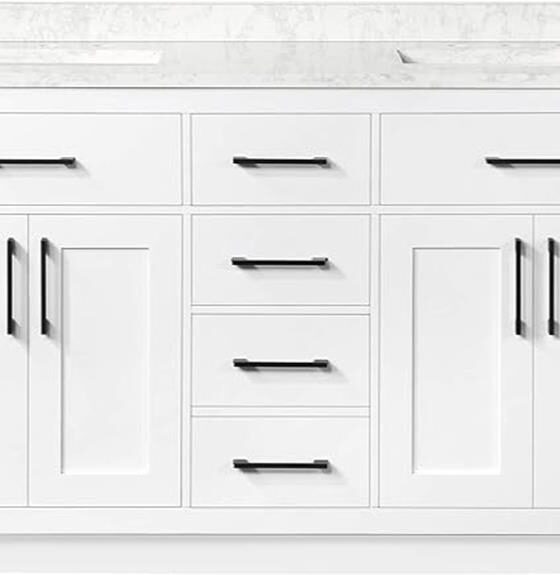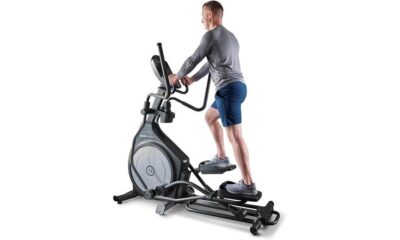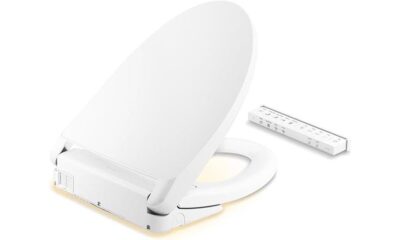Beginners Guides
Typical Door Handle Height

Have you ever felt the frustration of trying to reach a door handle that is just out of your reach? Did you realize that the average height of a door handle is 36 inches from the ground?
It's a seemingly small detail, but it can greatly impact our daily lives. But why does this matter, and how does it affect us in our homes and public spaces?
Let's explore the significance of door handle height and why it's worth our attention.
Key Takeaways
- Proper door handle height enhances accessibility, functionality, and aesthetic appeal.
- Door handle heights have evolved in response to changing societal needs and preferences.
- User ergonomics play a crucial role in determining suitable door handle height.
- Common standard door handle heights prioritize ergonomic considerations.
Importance of Proper Door Handle Height
Ensuring the proper height of door handles is crucial for accessibility, functionality, and overall aesthetic appeal of a space. When door handles are installed at the correct height, it offers numerous benefits.
From an ergonomic perspective, the correct placement reduces strain on the body, especially for individuals with mobility challenges. This not only enhances safety but also promotes a more comfortable experience for all users.
Aesthetically, properly positioned door handles contribute to the visual harmony of a room. They create a sense of balance and proportion that elevates the overall design.
Additionally, the functionality of a space is greatly improved when door handles are at the right height. It allows for smooth and effortless operation, enhancing the user experience and adding to the overall efficiency of the space.
Historical Evolution of Door Handle Heights

The historical evolution of door handle heights reflects shifting ergonomic needs, aesthetic preferences, and technical advancements, all of which are integral to understanding the design considerations that have shaped the accessibility and functionality of door handles over time.
- Evolution: Door handle heights have evolved in response to changing societal needs and preferences. Early door handles were often placed higher on the door, reflecting architectural styles and the materials available at the time. As society evolved, so did the placement and design of door handles, with a focus on improving usability and accessibility.
- Design Trends: The evolution of door handle heights has been influenced by design trends across different time periods. From ornate, decorative handles to sleek, minimalist designs, the aesthetic preferences of each era have played a significant role in shaping the evolution of door handle heights.
- Ergonomic Studies and Architectural Influence: The historical evolution of door handle heights has also been shaped by ergonomic studies and architectural influence. As our understanding of ergonomics has advanced, door handle heights have been adjusted to align with optimal user comfort and accessibility. Additionally, architectural movements and styles have influenced the design and placement of door handles, reflecting the broader design ethos of each period.
Factors Influencing Door Handle Height
In considering the optimal placement of door handles, ergonomic studies, architectural styles, and user accessibility are integral factors influencing door handle height.
User ergonomics play a crucial role in determining the most suitable height for door handles. This involves considering the average height of users and ensuring that the handles are easily reachable and operable without causing strain or discomfort. Additionally, ergonomic studies help determine the most natural and comfortable hand position for grasping the handle, enhancing overall user experience.
Architectural trends also significantly impact door handle height. Different architectural styles may favor varying door handle heights to complement the overall design aesthetic. For instance, modern architectural designs often feature lower door handle placements, aligning with sleek and minimalist aesthetics. On the other hand, traditional or classical architectural styles may incorporate higher door handle placements to align with historical design conventions.
Furthermore, user accessibility standards and regulations, such as those outlined in building codes and accessibility guidelines, must be considered when determining door handle height. These standards ensure that door handles are positioned at heights that cater to a diverse range of users, including individuals with disabilities, further emphasizing the importance of universally accessible door handle heights.
Common Standard Door Handle Heights
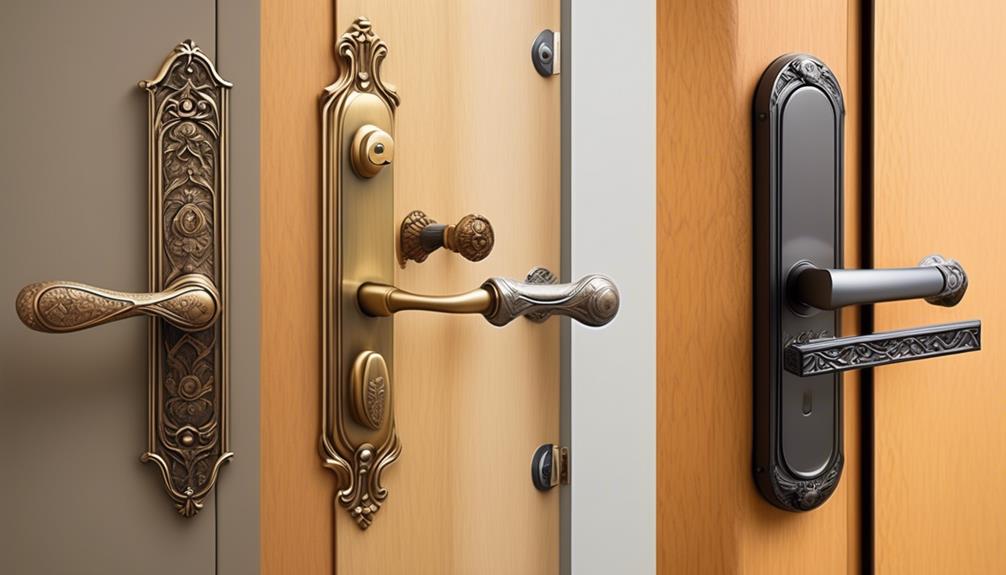
We carefully assess and determine the most suitable standard heights for door handles, considering ergonomic principles, architectural design, and accessibility standards. The common standard door handle heights are crucial for ensuring a seamless and comfortable user experience while complementing the overall interior design.
Our expertise in ergonomic design and understanding of interior design trends enable us to establish the following common standard door handle heights:
- Ergonomic Considerations: We prioritize the ergonomic aspect, ensuring that the door handle height allows for effortless operation without causing strain on the wrist or arm. This involves considering the average height and reach of the intended users to determine the most comfortable placement.
- Architectural Harmony: Our attention to detail extends to architectural design, where we aim to align the door handle height with other elements in the space, creating a cohesive and aesthetically pleasing environment.
- Accessibility Standards: We adhere to accessibility standards to accommodate individuals with varying abilities, ensuring that the door handle height facilitates easy access for everyone.
Our meticulous approach to determining common standard door handle heights reflects our commitment to integrating technical expertise with aesthetic considerations, resulting in a harmonious and functional design.
Considerations for Accessible Door Handle Heights
Employing an inclusive design approach, we meticulously evaluate the placement of door handles to ensure easy access for individuals with varying abilities. When considering accessible door handle heights, it's crucial to adhere to ADA requirements and prioritize ergonomic design.
The Americans with Disabilities Act (ADA) specifies that door handles must be installed at a height between 34 and 48 inches above the finished floor. This range ensures that individuals who use wheelchairs or have mobility impairments can comfortably reach and operate the handles. Additionally, ergonomic design principles play a pivotal role in determining the optimal handle height.
By considering factors such as hand size, grip strength, and range of motion, we can create door handle placements that accommodate a diverse range of users.
Incorporating accessible door handle heights not only addresses the needs of individuals with disabilities but also enhances the overall usability and inclusivity of a space. Our attention to detail and technical expertise in implementing these specifications ultimately contributes to a more aesthetically pleasing and functional environment.
Frequently Asked Questions
What Are the Most Popular Door Handle Materials Used in Modern Designs?
We often see eco-friendly materials like bamboo and recycled steel in modern door handle designs. These sustainable options provide durability and a sleek aesthetic.
Industrial finishes such as brushed nickel or matte black are also popular, giving a contemporary and stylish look to doors.
These materials aren't only visually appealing but also align with environmental values, making them a top choice for modern door handle designs.
Are There Any Cultural or Regional Variations in Preferred Door Handle Heights?
Cultural variations and regional preferences play a significant role in determining door handle heights. These factors are influenced by historical architectural styles, societal norms, and ergonomic considerations.
Understanding these nuances is crucial in creating door handle designs that cater to diverse cultural and regional needs. By incorporating these insights, we can ensure that our designs aren't only functional and ergonomic but also respectful of cultural and regional preferences.
How Do I Determine the Ideal Door Handle Height for My Specific Needs and Preferences?
Determining the ideal door handle height requires precision akin to threading a needle while riding a unicycle.
Door handle placement is crucial for accessibility considerations. We recommend considering factors such as ease of use, aesthetics, and ergonomics to find the perfect height.
It's essential to take into account individual needs and preferences, ensuring that the door handle is easily reachable and functional for all users.
Can Door Handle Height Impact the Overall Aesthetic of a Room or Building?
Absolutely, door handle height can greatly impact the overall aesthetic of a room or building. When considering interior design, ergonomic considerations are crucial, as the placement of door handles can affect the flow and functionality of a space.
Additionally, door handle height can be influenced by different architectural styles and historical influences, which can further enhance the overall aesthetic appeal of a room or building.
Are There Any Emerging Trends in Door Handle Design That Could Influence Future Standard Heights?
Design innovations and ergonomic considerations are driving emerging trends in door handle design, which could influence future standard heights.
As experts in this field, we meticulously analyze these trends to ensure our designs are at the forefront.
Our attention to detail and technical expertise allow us to anticipate and adapt to these changes, ensuring that our door handle designs not only meet but exceed the aesthetic expectations of our audience.
Does Carpet Wear and Tear Affect Door Handle Height?
Yes, the longevity of carpet lifespan can affect door handle height over time. As carpets wear and tear, they can compress, causing the door to sit lower. This can result in the need to adjust the door handle height to ensure easy operation. Regular carpet maintenance can help prevent this issue.
Conclusion
In conclusion, the proper height of a door handle is of utmost importance for both functional and aesthetic reasons.
It's the culmination of centuries of historical evolution and technical expertise, taking into account factors such as accessibility and ergonomics.
The standard door handle height is carefully considered to ensure ease of use and visual appeal.
In essence, the door handle height isn't just a small detail, but a crucial element that elevates the overall design and functionality of a space.
- About the Author
- Latest Posts
Introducing Ron, the home decor aficionado at ByRetreat, whose passion for creating beautiful and inviting spaces is at the heart of his work. With his deep knowledge of home decor and his innate sense of style, Ron brings a wealth of expertise and a keen eye for detail to the ByRetreat team.
Ron’s love for home decor goes beyond aesthetics; he understands that our surroundings play a significant role in our overall well-being and productivity. With this in mind, Ron is dedicated to transforming remote workspaces into havens of comfort, functionality, and beauty.
Beginners Guides
Can You Run Dishwasher and Washing Machine at Same Time
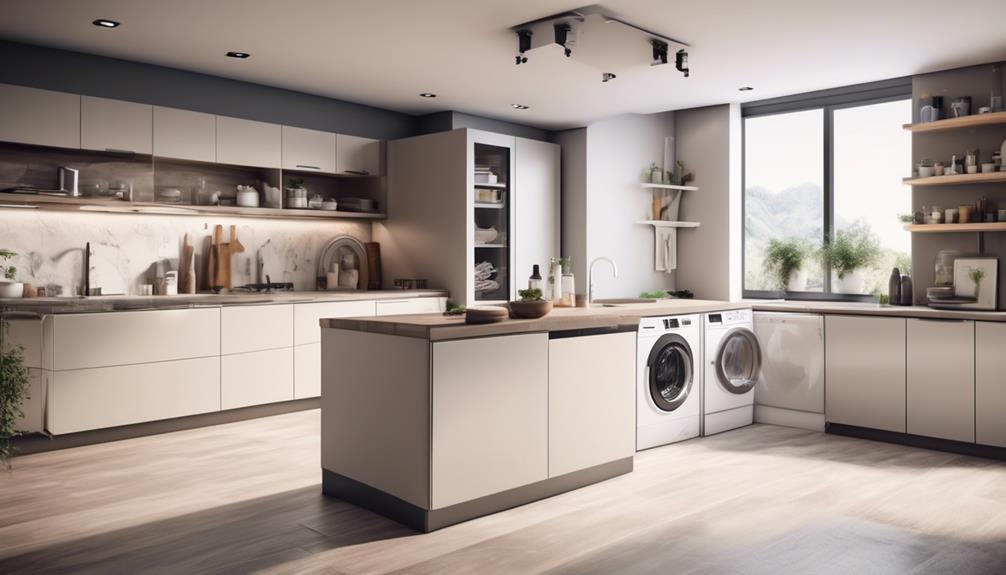
We’ve all experienced it – the never-ending stack of dirty dishes in the sink and a huge pile of laundry waiting to be done.
The temptation to tackle both tasks simultaneously can be strong, but before you hit start on both the dishwasher and washing machine, there are some important considerations to keep in mind.
Is it really safe to run both appliances at the same time, or could it potentially lead to some unexpected consequences?
Let's explore the potential risks and benefits of multitasking these household chores to ensure we're making the most efficient use of our time and resources.
Key Takeaways
- Running the dishwasher and washing machine at the same time can overload the water supply and drainage systems, leading to potential water leakage or pressure issues.
- Simultaneous use of these appliances increases energy consumption, contributing to higher electricity and water bills as well as a larger carbon footprint.
- High water usage from running both appliances simultaneously can impact water pressure and flow, so it's important to verify appliance compatibility and follow manufacturer's guidelines.
- Efficiently managing household chores through scheduling, multitasking, and improved time management can help alleviate the strain on the plumbing system caused by simultaneous use of the dishwasher and washing machine.
Potential Risks of Simultaneous Operation
Running the dishwasher and washing machine simultaneously can overload the water supply and drainage systems, potentially leading to water leakage or pressure issues. These risks arise from the increased demand for water and the strain on the drainage system when both appliances are in use at the same time.
When the water supply is unable to meet the demand, it can result in a drop in water pressure, affecting the performance of both appliances. Furthermore, the drainage system may struggle to cope with the simultaneous discharge of wastewater, increasing the likelihood of leaks or backups.
To mitigate these risks, certain safety precautions should be observed. First, it's advisable to stagger the operation of the dishwasher and washing machine to lessen the strain on the water supply and drainage systems. Additionally, routine maintenance of the plumbing and appliances can help identify and address any potential issues before they escalate.
Moreover, installing a pressure regulator and ensuring proper ventilation of the drainage system can contribute to preventing water leakage or pressure problems when using both appliances concurrently.
Understanding the risks and implementing safety precautions is essential for maintaining the efficient and safe operation of the dishwasher and washing machine.
Impact on Energy Consumption
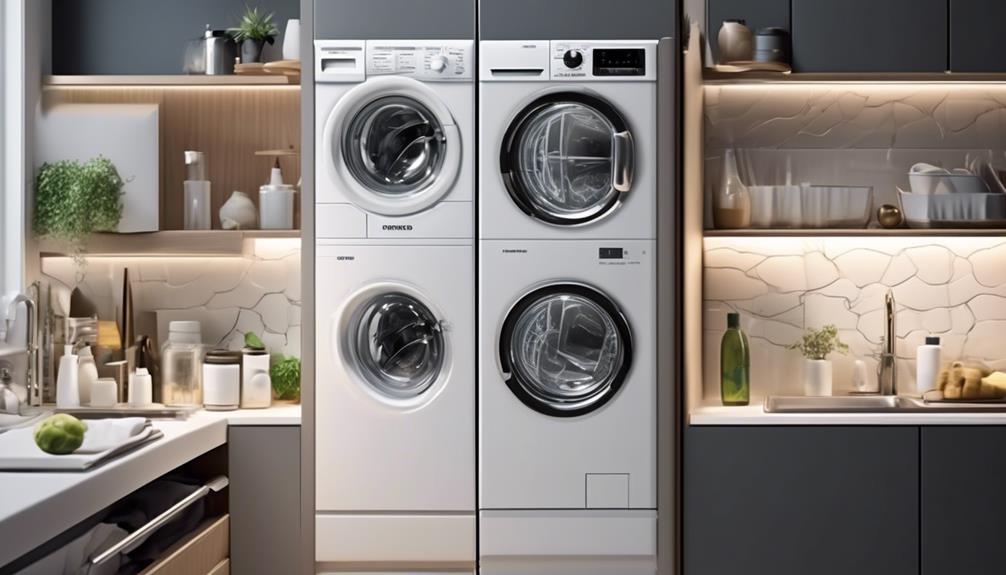
Considering the potential strain on the water supply and drainage systems when both appliances are in use, it's important to assess the impact on energy consumption. Running the dishwasher and washing machine simultaneously can have significant implications for energy usage, costs, and the environment.
Here are the key points to consider:
- Cost implications: Simultaneously running the dishwasher and washing machine can lead to higher energy bills due to increased electricity and water consumption. This can have a direct impact on household expenses, making it essential to evaluate the financial aspects of this practice.
- Environmental impact: Increased energy consumption contributes to a higher carbon footprint. Running both appliances at the same time may strain energy resources and add to environmental concerns. It's crucial to consider the ecological implications of such actions.
- Load balancing, appliance longevity: Overloading the electrical circuits can lead to inefficiencies and potential damage to the appliances. Proper load balancing and staggered usage can help maintain the longevity of the dishwasher and washing machine, reducing the risk of wear and tear.
Understanding the energy implications of running these appliances concurrently is essential for making informed decisions about household chores and resource management.
Effects on Water Pressure and Flow
When using both the dishwasher and washing machine simultaneously, it's important to be mindful of the potential impact on water pressure and flow. Running these appliances together can strain the water supply, leading to reduced pressure and flow. To better understand the effects of simultaneous use, let's consider the water usage and appliance compatibility.
| Water Usage | Appliance Compatibility |
|---|---|
| High | Check manufacturer's recommendations for simultaneous use. |
| Increased consumption | Ensure both appliances are compatible with your home's water pressure. |
| Potential strain on water supply | Avoid using both appliances during peak water usage times. |
| Can lead to reduced flow | Consider upgrading to high-efficiency appliances to minimize water usage. |
High water usage during simultaneous operation can overwhelm the supply, impacting the flow and pressure. Therefore, it's crucial to verify the compatibility of the appliances with your home's water pressure and to follow the manufacturer's guidelines. Additionally, being mindful of peak water usage times and considering high-efficiency appliances can help mitigate the strain on water pressure and flow.
Tips for Efficiently Managing Household Chores
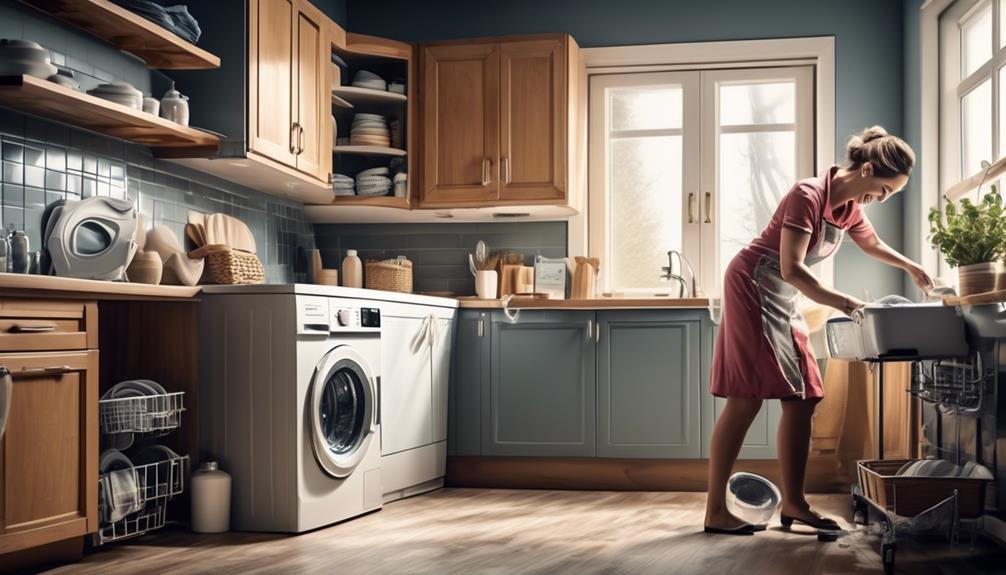
We find that dividing household chores among family members can lead to more efficient and manageable task completion. When it comes to efficiently managing household chores, time management and multitasking efficiency are crucial.
Here are some tips to help streamline the process:
- Create a Schedule: Establish a weekly schedule that allocates specific tasks to each family member. This not only ensures that all chores are covered but also prevents duplication of efforts.
- Utilize Multitasking: Encourage multitasking by combining activities that can be done simultaneously. For instance, while waiting for the dishwasher to finish its cycle, use that time to fold laundry or tidy up the kitchen.
- Regular Check-Ins: Conduct regular family meetings to discuss the chore schedule and address any challenges or bottlenecks that may have arisen. Open communication ensures that everyone is on the same page and allows for adjustments to be made as needed.
Considerations for Plumbing System
Efficiently managing household chores, such as dividing tasks and utilizing multitasking, can also extend to considering the impact on the plumbing system when running the dishwasher and washing machine simultaneously.
When running both appliances at the same time, it's crucial to consider the pipe capacity and water supply of your plumbing system. The pipe capacity refers to the ability of your pipes to handle the volume of water flowing through them. If the pipe capacity is exceeded, it can lead to issues such as low water pressure or even potential leaks.
Similarly, the water supply must be able to meet the demands of both appliances running concurrently. If the water supply is insufficient, it can cause disruptions in the proper functioning of the dishwasher and washing machine.
To ensure the smooth operation of these appliances, it's advisable to check the pipe capacity and water supply of your plumbing system. Upgrading to larger pipes or installing a higher capacity water supply can help prevent any potential issues when running the dishwasher and washing machine simultaneously.
Frequently Asked Questions
Is It Safe to Run the Dishwasher and Washing Machine at the Same Time if They Are on Different Floors of the House?
It's important to consider appliance compatibility and water consumption when running the dishwasher and washing machine simultaneously on different floors. Running both appliances at the same time can strain the water supply and affect their performance.
It's generally best to stagger the use of these high-water-usage appliances to avoid potential issues. Additionally, be mindful of the overall water pressure in the house to ensure both appliances function optimally.
Will Running Both Appliances Simultaneously Significantly Increase My Water and Electricity Bills?
Running both appliances simultaneously can significantly increase our water and electricity bills. It's important to consider energy efficiency and cost when using household appliances. This impacts our environmental footprint and sustainability efforts.
To minimize the impact, we could stagger the use of these appliances or consider upgrading to more energy-efficient models. Being mindful of our usage helps in reducing costs and our environmental impact.
How Will Simultaneous Operation Affect the Water Pressure in Other Areas of the House, Such as the Shower or Sink?
Simultaneous operation of the dishwasher and washing machine may affect the water pressure in other areas of the house, like the shower or sink. Running both appliances at once could potentially cause a drop in water pressure, impacting the performance of other fixtures.
It's important to consider the capacity of your water supply system and the flow rate of each appliance to ensure consistent water pressure throughout the house.
Are There Any Specific Time-Saving Strategies for Managing Household Chores When Running the Dishwasher and Washing Machine at the Same Time?
Running the dishwasher and washing machine simultaneously can be efficient. Time-saving strategies include pre-sorting laundry, using quick wash cycles, and loading the dishwasher efficiently.
This allows us to optimize water and energy usage, saving time and resources. Additionally, coordinating these tasks with other household chores can maximize efficiency, such as preparing meals or tidying up.
What Potential Impact Could Running Both Appliances at the Same Time Have on the Overall Health and Function of My Home's Plumbing System?
Running both appliances simultaneously can strain your plumbing system. The impact on the overall health and function of the plumbing could lead to issues like drainage problems and water pressure fluctuations.
It's crucial to consider the compatibility of appliances to prevent overloading the system. The strain from simultaneous usage can affect the longevity of the plumbing and appliances.
It's wise to stagger the use of these appliances to maintain a healthy plumbing system.
Is it Safe to Run the Dishwasher and Washing Machine at the Same Time?
Running dishwasher and washing machine at the same time may put a strain on your water heater, causing a decrease in water pressure. It can also overload your electrical circuit, leading to potential safety hazards. It’s best to stagger the use of these appliances to avoid any issues.
Conclusion
So, can you run the dishwasher and washing machine at the same time?
While it may seem like a time-saving idea, it's best to avoid it to prevent potential risks to your plumbing system and ensure efficient use of energy and water.
Remember, when it comes to household chores, it's better to take things one at a time and avoid biting off more than we can chew.
- About the Author
- Latest Posts
Introducing Ron, the home decor aficionado at ByRetreat, whose passion for creating beautiful and inviting spaces is at the heart of his work. With his deep knowledge of home decor and his innate sense of style, Ron brings a wealth of expertise and a keen eye for detail to the ByRetreat team.
Ron’s love for home decor goes beyond aesthetics; he understands that our surroundings play a significant role in our overall well-being and productivity. With this in mind, Ron is dedicated to transforming remote workspaces into havens of comfort, functionality, and beauty.
Beginners Guides
Do More Fan Blades Move More Air
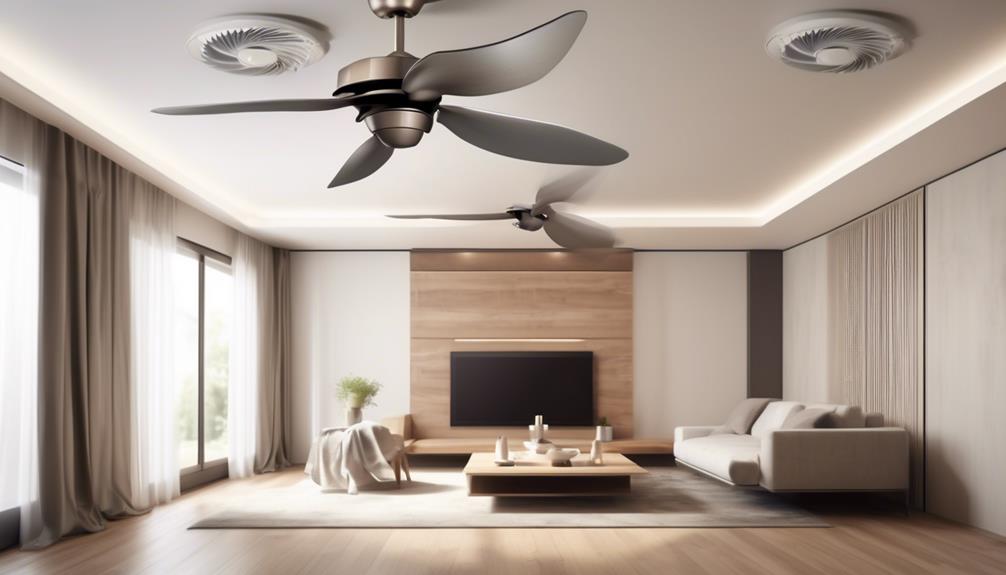
We have all heard that having more fan blades results in improved air circulation, but does this widely held belief withstand scientific investigation?
When it comes to selecting a fan for optimal airflow, there are a multitude of factors to consider beyond just the number of blades.
From the design of the blades to the motor and the size of the fan, there's a lot that goes into determining how much air a fan can move.
So, if you've ever wondered whether more fan blades actually result in more air movement, the answer might surprise you.
Key Takeaways
- Blade design is crucial in determining fan performance.
- Well-designed blades can move more air even with fewer blades.
- Blade shape significantly impacts airflow efficiency.
- Factors like number of blades, curvature, and spacing impact airflow efficiency.
The Science Behind Fan Blades
Understanding the aerodynamics of fan blades is essential for comprehending how they efficiently move air within a given space. Blade design plays a crucial role in determining the performance of a fan. Different blade shapes and angles are engineered to manipulate airflow dynamics. The design of a fan blade is a delicate balance between maximizing airflow and minimizing noise. By optimizing the curvature, width, and pitch of the blades, engineers can tailor the airflow to meet specific requirements.
Blade design directly impacts the efficiency and effectiveness of a fan. The angle of the blades, known as the pitch angle, determines the amount of air that can be moved with each rotation. Moreover, the shape of the blade influences how the air is propelled, affecting the distribution and velocity of the airflow. These factors are critical in various applications, from cooling systems in electronic devices to industrial ventilation.
Factors Affecting Air Movement
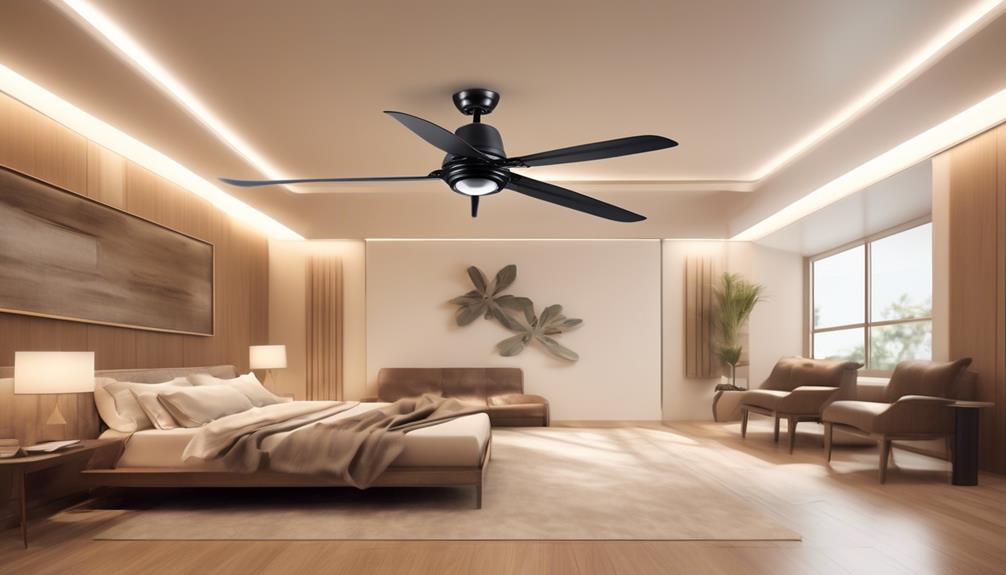
To maximize air movement, it's essential to consider various factors that directly impact the efficiency and effectiveness of a fan.
Airflow efficiency is a critical factor affecting air movement. It's determined by the design of the fan blades and their ability to move air with minimal energy input.
The blade design plays a crucial role in determining the airflow efficiency of a fan. The shape, size, and angle of the blades directly influence the amount of air that can be moved within a given time frame. Additionally, factors such as the number of blades, their curvature, and the spacing between them also impact airflow efficiency.
Optimal blade design can significantly enhance the overall performance of a fan, ensuring that it moves air effectively and efficiently.
Furthermore, the materials used in the construction of fan blades can also affect their ability to move air. Lightweight and durable materials can contribute to improved airflow efficiency by reducing the energy required to rotate the blades.
Understanding and optimizing these factors are essential in designing fans that can move air with maximum efficiency, making them indispensable in various applications.
Myth Busting: More Blades, More Air?
When evaluating the relationship between the number of fan blades and the amount of air moved, it's imperative to consider empirical evidence and technical analysis. Blade design plays a crucial role in determining airflow efficiency. Here are some key points to consider:
- Blade Design: The shape and angle of the fan blades significantly impact the airflow efficiency. A well-designed blade can move more air even with fewer blades, challenging the notion that more blades always equate to more air movement.
- Airflow Efficiency: The focus should be on maximizing airflow efficiency rather than simply increasing the number of blades. Efficiency can be enhanced through aerodynamic principles, blade curvature, and material selection.
- Turbulence Reduction: A carefully designed blade can reduce turbulence, improving airflow and overall fan performance.
- Motor Power: In some cases, increasing the number of blades may require a more powerful motor to maintain optimal airflow efficiency, leading to higher energy consumption.
- Practical Testing: Real-world testing and analysis of airflow patterns and pressure differentials are essential to determine the actual impact of blade numbers on air movement.
Considering these factors, it becomes evident that the relationship between the number of fan blades and the amount of air moved is more nuanced than a simple 'more blades, more air' assumption. Efficient blade design and airflow optimization are crucial in determining the actual air-moving capacity of a fan.
Optimizing Airflow With Fan Blades
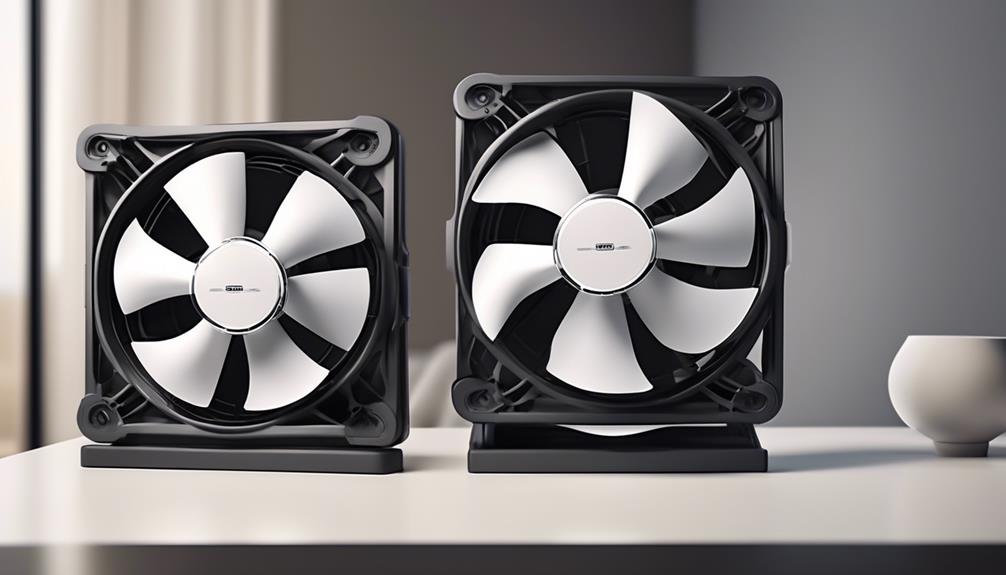
Considering the nuanced relationship between fan blade design and airflow efficiency, optimizing the configuration of fan blades is imperative in maximizing air movement capacity. Blade design plays a crucial role in determining the efficiency of air movement within a fan system. By carefully considering factors such as blade shape, angle of attack, and material composition, engineers can fine-tune fan blades to achieve optimal airflow efficiency.
In blade design, the shape of the blade significantly impacts airflow efficiency. A carefully sculpted blade can minimize turbulence and maximize the transfer of kinetic energy to the air, resulting in improved overall airflow. Additionally, the angle of attack, which determines the angle at which the blade meets the oncoming air, directly influences the effectiveness of air movement. By adjusting this angle, engineers can optimize the lift and drag forces acting on the fan blades, thus enhancing airflow efficiency.
Furthermore, the material composition of fan blades is a critical consideration in optimizing airflow. The choice of materials can impact the weight, strength, and aerodynamic properties of the blades, ultimately affecting their ability to move air efficiently. By leveraging advanced materials and manufacturing techniques, engineers can design fan blades that minimize energy losses and maximize airflow efficiency.
Practical Considerations for Effective Air Circulation
In practical applications, ensuring effective air circulation necessitates meticulous attention to fan placement and orientation, as well as the use of appropriate fan speed control mechanisms.
When considering fan placement, size plays a crucial role in determining the coverage area and the amount of air moved. A larger fan is generally more effective at circulating air over a greater distance, while smaller fans are suitable for localized cooling.
Additionally, the angle and material of the fan blades significantly impact airflow. Adjusting the blade angle can optimize air movement for specific environments, while the material affects durability and efficiency.
Orientation for optimal air circulation is also important to consider. Placing fans strategically to create a cross-flow pattern can help in circulating air effectively throughout a space.
Utilization of appropriate fan speed control mechanisms is essential to regulate the airflow according to the specific needs and conditions. Speed control mechanisms such as variable frequency drives or fan controllers allow for adjusting the fan speed to achieve the desired airflow rate.
Furthermore, when aiming for efficient air movement, it is vital to consider environmental factors such as the layout of the space, the presence of obstacles, and the temperature gradient. These factors can impact the effectiveness of air circulation and should be taken into account when designing the fan system.
Frequently Asked Questions
How Do Different Materials Used to Make Fan Blades Affect Air Movement?
Different materials used to make fan blades affect air movement in several ways. The weight and shape of the blades are influenced by the material used, which in turn impacts airflow. The density and rigidity of the material determine its weight, which can affect the blades' ability to move air efficiently. Additionally, the material's acoustic properties contribute to the noise levels produced during operation. On top of that, the shape of the blade itself plays a critical role in directing airflow. Therefore, understanding these factors is crucial for optimizing fan blade design and ultimately improving performance.
Can the Angle of the Fan Blades Impact How Much Air Is Moved?
The angle of the fan blades can significantly impact the amount of air moved.
The shape and weight of the blades play a crucial role in airflow, and the efficiency of curved blades can enhance overall performance.
We've observed that adjusting the angle of the blades can optimize airflow in various settings.
Understanding these dynamics allows us to design and fine-tune fan blades for maximum efficiency and air movement.
What Impact Does the Motor Size Have on the Amount of Air Moved by the Fan Blades?
When considering the impact of motor size on airflow, we find that larger motors can effectively power fan blades for increased airflow.
However, efficiency is also crucial, as a well-designed blade can maximize airflow with a smaller motor.
It's like pairing the right engine with a sports car – a powerful motor is important, but the design and efficiency of the car's body also play a critical role in achieving top speed.
Are There Any Safety Considerations to Keep in Mind When Using Fans With a Larger Number of Blades?
When considering fan blade safety, it's crucial to evaluate airflow efficiency and blade material properties.
A larger number of blades can potentially lead to increased airflow, but it's essential to ensure that the motor can handle the load and that the angle adjustment is appropriate for the increased blade count.
Additionally, the material properties of the blades should be inspected to guarantee structural integrity and safe operation.
How Does the Speed of the Fan Blades Affect the Amount of Air Circulated in a Room?
When considering the speed of fan blades and its impact on airflow, blade design and efficiency come into play.
Modern airflow control technology has revolutionized fan functionality, allowing for precise adjustments and optimal airflow.
Through advancements in blade design, fans can now move more air at higher speeds without sacrificing efficiency.
This technological progress has significantly improved the ability of fans to circulate air in a room, offering better air distribution and comfort.
– Do Ceiling Fans with More Blades Really Move More Air?
When it comes to the number of blades on a ceiling fan, more blades don’t necessarily mean more airflow. In fact, a fan with fewer blades can often move air more efficiently. The design and angle of the blades, as well as the motor, play a larger role in determining airflow than the number of blades.
Conclusion
In conclusion, it's clear that the number of fan blades doesn't necessarily equate to more air movement. While some may believe that more blades lead to greater airflow, the science behind fan blades tells a different story.
By optimizing the design and angle of the blades, one can achieve more effective air circulation regardless of the number of blades.
So, next time you're in the market for a fan, remember that more isn't always better.
- About the Author
- Latest Posts
Introducing Ron, the home decor aficionado at ByRetreat, whose passion for creating beautiful and inviting spaces is at the heart of his work. With his deep knowledge of home decor and his innate sense of style, Ron brings a wealth of expertise and a keen eye for detail to the ByRetreat team.
Ron’s love for home decor goes beyond aesthetics; he understands that our surroundings play a significant role in our overall well-being and productivity. With this in mind, Ron is dedicated to transforming remote workspaces into havens of comfort, functionality, and beauty.
Beginners Guides
Soundproof Bed Tent

In the midst of our daily chaos, we frequently look for a safe haven in the form of a serene, peaceful space.
Imagine being able to cocoon yourself in a haven where the outside world fades away, and serenity reigns supreme.
The concept of a soundproof bed tent offers just that – a retreat from the noise and distractions that can disrupt our sleep and peace of mind.
But what exactly makes a soundproof bed tent so effective, and how can it revolutionize our sleep experience?
Let's explore the benefits, features, and real customer experiences to uncover the full potential of this innovative solution.
Key Takeaways
- Soundproof bed tents improve sleep quality by reducing external noise disturbances.
- They create a serene sleep environment free from disruptions.
- These tents block out ambient noise for a restful night's sleep.
- They enhance cognitive function and mood regulation.
Benefits of Using a Soundproof Bed Tent
Using a soundproof bed tent can significantly improve sleep quality by reducing external noise disturbances. This privacy solution creates a serene sleep environment, free from the disruptions of household or neighborhood sounds. The innovative design of the tent blocks out ambient noise, providing a cocoon of tranquility for a restful night's sleep. With improved sleep quality, individuals can experience enhanced cognitive function, better mood regulation, and overall well-being.
Moreover, the soundproof bed tent offers a private sanctuary, especially beneficial for those living in shared spaces or open floor plans. It provides a personal retreat within the confines of one's bedroom, allowing for undisturbed relaxation, reading, or meditation.
The privacy solution also serves as a dedicated space for individuals to focus on personal hobbies or work without external interference.
Features of the Soundproof Bed Tent
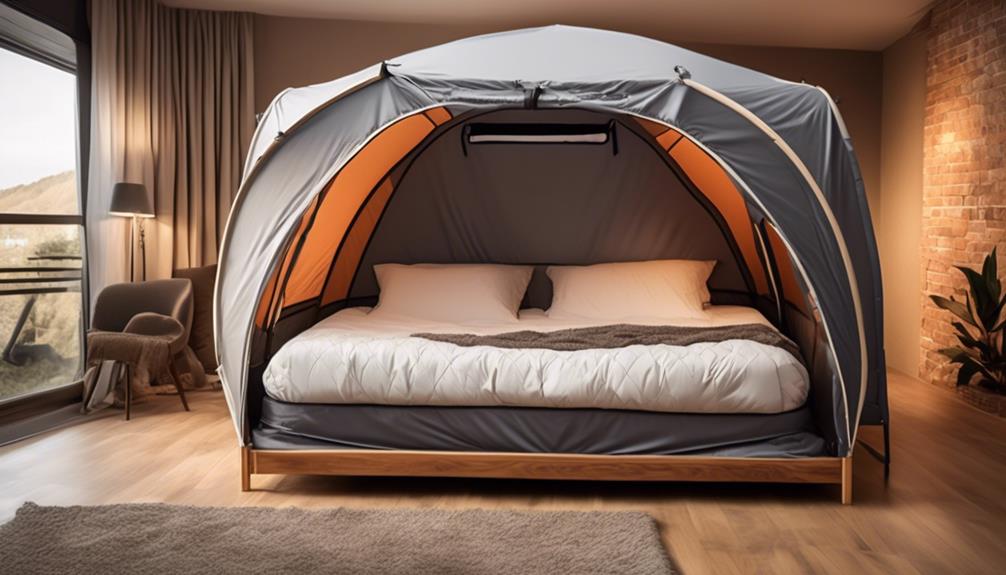
The soundproof bed tent is designed with specialized materials and construction to effectively minimize external noise and create a peaceful sleep environment. This innovative product incorporates advanced noise reduction technology and soundproofing materials to ensure a restful night's sleep.
The following features make it a must-have for anyone seeking a tranquil sleeping space:
- Triple-Layer Soundproof Fabric: The tent is constructed with a triple-layered fabric that effectively absorbs and dampens external sounds, creating a serene sleeping environment.
- Seamless Zipper Closure: The seamless zipper closure not only provides easy access but also acts as an additional barrier to block out noise from the surroundings.
- Reinforced Frame Design: The sturdy frame is designed to minimize vibrations and disturbances, further enhancing the soundproofing capabilities of the tent.
- Adjustable Ventilation: While keeping noise out is a priority, the tent also features adjustable ventilation to ensure a comfortable airflow without compromising soundproofing.
- Spacious Interior: Despite its focus on soundproofing, the tent offers ample space for a comfortable sleeping experience, allowing users to move freely while enjoying a peaceful ambiance.
With these features, the soundproof bed tent offers a comprehensive solution for those seeking to create a quiet and restful sleep environment.
How to Set Up the Soundproof Bed Tent
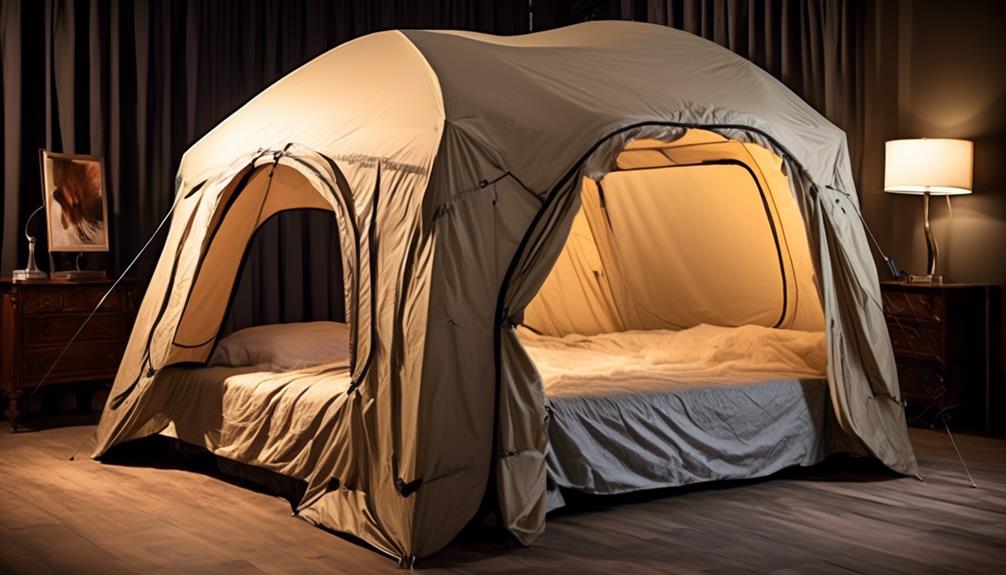
After unboxing the soundproof bed tent, carefully lay out the components to prepare for assembly.
Setting up the soundproof bed tent requires attention to detail to ensure optimal noise reduction. Begin by unfolding the tent fabric and securing the frame according to the provided instructions.
The assembly process is straightforward, with clear steps for attaching the poles and securing the tent in place.
The innovative soundproofing technology integrated into the fabric and design of the tent enhances its noise reduction capabilities, creating a peaceful sleep environment.
As we carefully follow the assembly process, we appreciate the thoughtfulness put into the soundproofing features, which contribute to a quieter and more restful sleeping experience.
Once the tent is set up, take a moment to appreciate the quality of the materials and the effectiveness of the soundproofing technology.
With the soundproof bed tent in place, we can look forward to enjoying a tranquil space that promotes relaxation and undisturbed sleep.
Tips for Maximizing Soundproofing Effectiveness
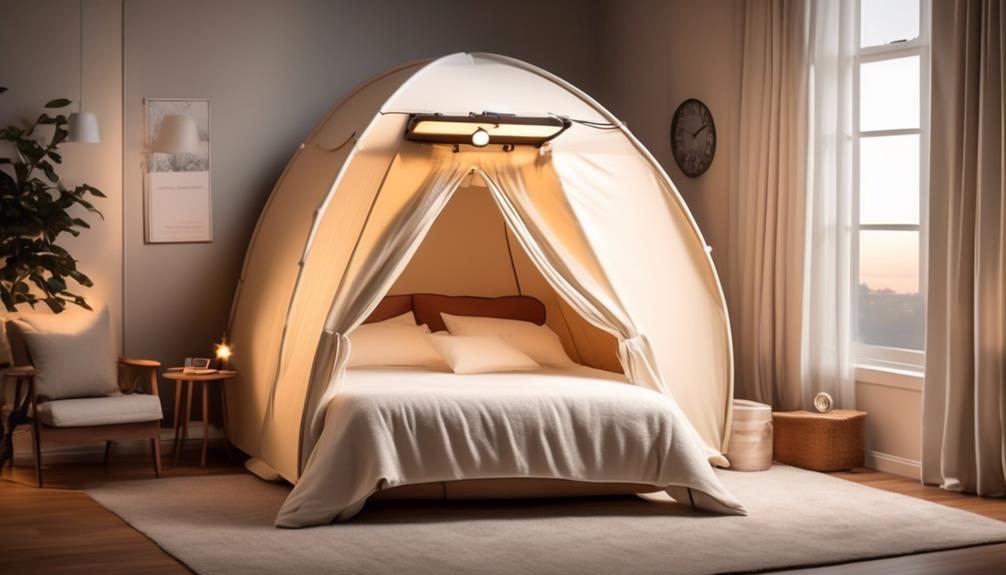
To enhance the soundproofing effectiveness, consider adding additional layers of sound-absorbing materials to the interior walls of the tent. This can be achieved by using heavy curtains, acoustic foam panels, or soundproof blankets to create a barrier against external noises. Additionally, placing thick rugs or carpets on the floor can further absorb sound vibrations, maximizing the tent's soundproofing benefits.
- Opt for Heavy Drapes: Choose thick, heavy drapes that can effectively block out noise and provide an extra layer of sound insulation.
- Use Acoustic Sealant: Apply acoustic sealant to seal any gaps or cracks in the tent's walls, windows, or doors, preventing sound leakage.
- Install Soundproofing Wallpaper: Consider using soundproofing wallpaper, which contains noise-dampening materials and can significantly reduce external sounds.
- Utilize Weather Stripping: Apply weather stripping to the tent's windows and doors to create a tight seal, minimizing sound transmission.
- Customize with Customer Reviews: Research customer reviews of soundproofing materials to find the most effective options for your specific needs.
Real Customer Reviews and Testimonials
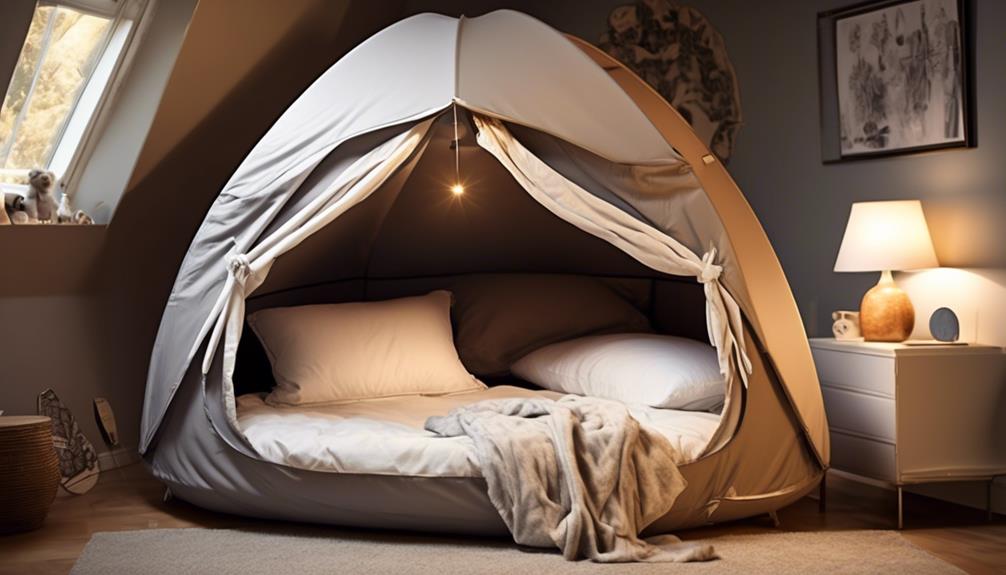
Considering the effectiveness of soundproofing materials, we were eager to discover the real experiences and feedback from customers who've used similar products in their own environments. Customer satisfaction is a key factor in assessing the performance of soundproofing solutions.
Many users have reported significant noise reduction and improved sleep quality after using soundproof bed tents. One customer mentioned, 'I was skeptical at first, but the soundproof bed tent exceeded my expectations. It has made a noticeable difference in reducing the noise from outside and has significantly improved my sleep.'
Another customer expressed, 'I live in a noisy apartment complex, and the soundproof bed tent has been a game-changer. I no longer wake up to the sounds of traffic and neighbors, and it has greatly enhanced my overall satisfaction with my living space.'
These testimonials highlight the positive impact of soundproof bed tents on customer satisfaction and noise reduction. It's clear that real users have experienced tangible benefits from incorporating soundproofing solutions into their daily lives.
Frequently Asked Questions
Can the Soundproof Bed Tent Be Used for Outdoor Camping?
Yes, the soundproof bed tent can be used for outdoor camping. It provides noise reduction and privacy solution, making it suitable for outdoor activities.
The tent's soundproof features help create a peaceful environment for sleeping, and its design offers a comfortable and private space during camping.
The soundproof bed tent is a great option for those seeking a peaceful and undisturbed outdoor camping experience.
Is the Soundproof Bed Tent Suitable for Use in Hot Climates?
In hot climates, it's essential to consider the breathability and insulation of the tent. When it comes to soundproof tents, it's crucial to ensure that they offer proper ventilation and cooling features to make them suitable for hot weather.
Additionally, outdoor camping suitability in warm climates requires UV protection, durable materials, and a design that allows for airflow. These factors are important to consider when assessing the suitability of the soundproof bed tent for use in hot climates.
What Materials Are Used to Make the Soundproof Bed Tent?
When it comes to the materials used in the construction of our soundproof bed tent, we've carefully selected a combination of high-quality insulation and noise-reducing fabrics. These materials not only provide excellent soundproofing but also ensure durability for outdoor use, making it perfect for camping or any other outdoor activities.
Our construction techniques guarantee a peaceful and undisturbed rest, regardless of the noise level outside.
Can the Soundproof Bed Tent Fit a Queen-Size Bed?
Yes, the soundproof bed tent can fit a queen-size bed.
It provides bedroom privacy and ensures a comfortable, soundproof environment.
Our soundproof bed tent is specifically designed to accommodate queen-size beds, making it perfect for those seeking a peaceful and private sleeping space.
With its ability to fit a queen-size bed, it offers a great solution for creating a quiet and private area for relaxation and rest.
Are There Any Additional Accessories or Add-Ons Available for the Soundproof Bed Tent?
Yes, there are additional accessories and add-ons available for the soundproof bed tent. These include soundproofing panels and curtains to enhance soundproofing effectiveness.
Additionally, there are customization options such as different colors and materials for the tent, as well as add-ons like storage pockets and lighting fixtures.
These options allow for personalized adjustments to elevate the overall experience and functionality of the bed tent.
How Does a Soundproof Canopy Bed Compare to a Soundproof Bed Tent?
When comparing a soundproof canopy bed option to a soundproof bed tent, there are a few key differences to consider. The canopy bed offers a more luxurious and elegant option, while the bed tent is more practical and portable. Both provide soundproofing, but the choice ultimately depends on personal preference and lifestyle.
Conclusion
So, if you're looking for a peaceful and quiet night's sleep, the soundproof bed tent is definitely worth considering.
With its easy setup and effective soundproofing features, it's a game-changer for anyone who struggles with noise disturbances.
But don't just take our word for it, why not try it out for yourself and experience the difference?
- About the Author
- Latest Posts
Introducing Ron, the home decor aficionado at ByRetreat, whose passion for creating beautiful and inviting spaces is at the heart of his work. With his deep knowledge of home decor and his innate sense of style, Ron brings a wealth of expertise and a keen eye for detail to the ByRetreat team.
Ron’s love for home decor goes beyond aesthetics; he understands that our surroundings play a significant role in our overall well-being and productivity. With this in mind, Ron is dedicated to transforming remote workspaces into havens of comfort, functionality, and beauty.
-

 Vetted3 weeks ago
Vetted3 weeks ago15 Best Contact Paper for Kitchen Cabinets to Elevate Your Home Decor
-

 Vetted6 days ago
Vetted6 days ago15 Best Poe Cameras for Home Security – Reviews & Buying Guide
-

 Vetted3 weeks ago
Vetted3 weeks ago15 Best Leather Restorer Products to Revive Your Furniture and Accessories
-

 Vetted4 weeks ago
Vetted4 weeks ago15 Best Leg Massagers to Relieve Tension and Improve Circulation – Ultimate Guide
-

 Vetted2 weeks ago
Vetted2 weeks ago15 Best Drain Snakes to Unclog Your Pipes Like a Pro
-

 Vetted4 weeks ago
Vetted4 weeks ago15 Best Lawn Games for Adults to Elevate Your Outdoor Gatherings
-

 Vetted3 weeks ago
Vetted3 weeks ago14 Best Stationery Brands for Your Next Writing Adventure
-

 Beginners Guides1 week ago
Beginners Guides1 week agoSwinger Porch Light Color

















